阅前提示:本文远非专业论文,仅为个人学习过程的记录,仅供个人学习使用。本文所有内容均没有科学理论支撑,请谨慎甄别。
Note before reading: This article is far from a professional paper; it is merely a record of my personal learning process and is intended for personal study use only. None of the content is supported by scientific theory, so please exercise caution and discernment.
我已经不止一次听到“batch size建议开大一点”的说法了。目前的主流观点,batch size似乎是根据显卡的性能决定的,显存越大,batch size就能开得越大,就好像batch size越大越好一样。真的是这样吗?
I have heard the suggestion 'increase the batch size a bit' more than once. The current mainstream view seems to be that the batch size is determined by the performance of the graphics card—the larger the vram, the larger the batch size can be, as if the larger the batch size, the better. Is this really the case?
理论上说,batch size是模型训练时同时学习的图片数量,增大batch size可以加快模型的拟合。但是,加快了学习速率之后,难道就不会对学习效果产生影响吗?
Theoretically, the batch size is the number of images the model learns simultaneously during training. Increasing the batch size can speed up the model's fitting. However, doesn't increasing the learning speed affect the learning outcomes?
我之前训练过《喜羊羊与灰太狼》中的若干角色的Lora模型(只不过都是私模,不开源)。我比较习惯的训练方法是,找70张左右的图片,repeat设为6,batch size设为1。学习率是这样确定的,优化器先用DAdaptation,训练1个epoch,找到合适的学习率大小,然后把这个值除以3,填入学习率中,并把优化器改为Lion,调度器改为cosine with restarts,把文本编码器的学习率设为unet学习率的1/10。训练8个epoch左右,即3000步左右,最后出xy图表做挑选。别问我为什么这样练,问就是从各种地方看到的经验加我自己的经验。
I previously trained LoRA models for several characters from 'Pleasant Goat and Big Big Wolf', a Chinese cartoon (but they are all private models and not open-sourced). My usual training method is to collect around 70 images, set repeat to 6, and batch size to 1. The learning rate is determined as follows: first, use DAdaptation optimizer to train for 1 epoch and find the appropriate learning rate, then divide this value by 3 and set it as the learning rate, switch the optimizer to Lion, and change the scheduler to cosine with restarts, setting the learning rate for the text encoder to 1/10 of the unet learning rate. I train for around 8 epochs, which is about 3000 steps, and finally produce XY charts for selection. Don't ask me why I train this way—it's based on a combination of various sources of experience and my own.
在训练沸羊羊的模型的时候,我就尝试过把batch size从1调到2,发现拟合效果明显变好了(详见:【AI绘画沸羊羊_V1.5】SD1.5 Lora炼丹笔记 - 哔哩哔哩 (bilibili.com))。但是,同样的方法在喜羊羊的模型和灰太狼的模型上却没有明显的效果,如下图:
When training the model for Sparky, the character, I tried increasing the batch size from 1 to 2 and noticed a significant improvement in fitting (see: 【AI绘画沸羊羊_V1.5】SD1.5 Lora炼丹笔记 - 哔哩哔哩 (bilibili.com)). However, the same method did not yield noticeable effects on the models for Weslie and Wolffy, as shown in the figure below:
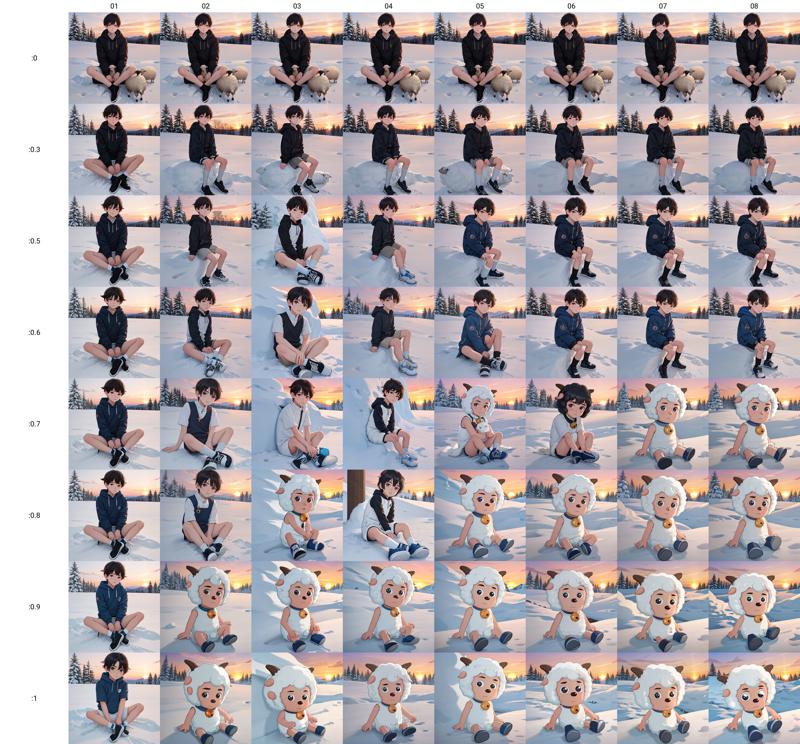
喜羊羊 batch size=1 Weslie, batch size=1
横轴为epoch,纵轴为模型权重,下同。
Horizontal axis represents epochs, and Vertical axis represents model weights. The same applies to all following figures.
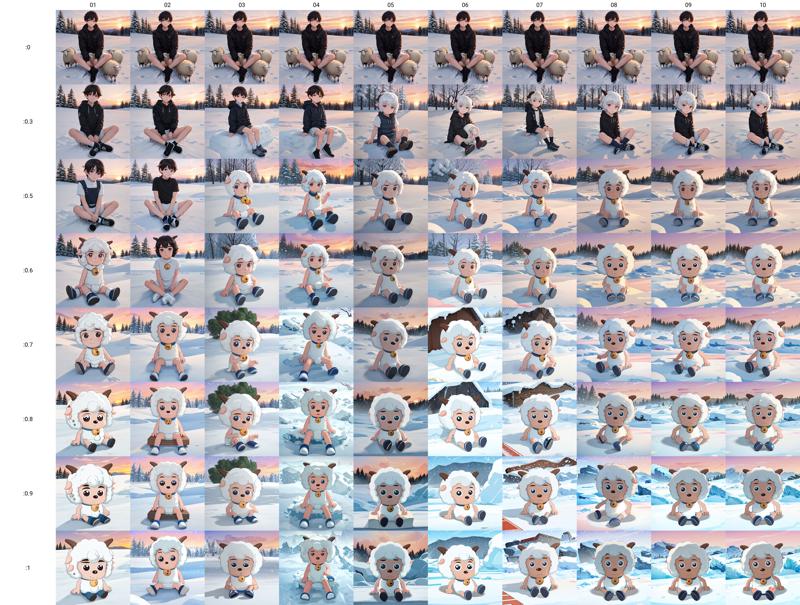
喜羊羊 batch size=2 Weslie, batch size=2
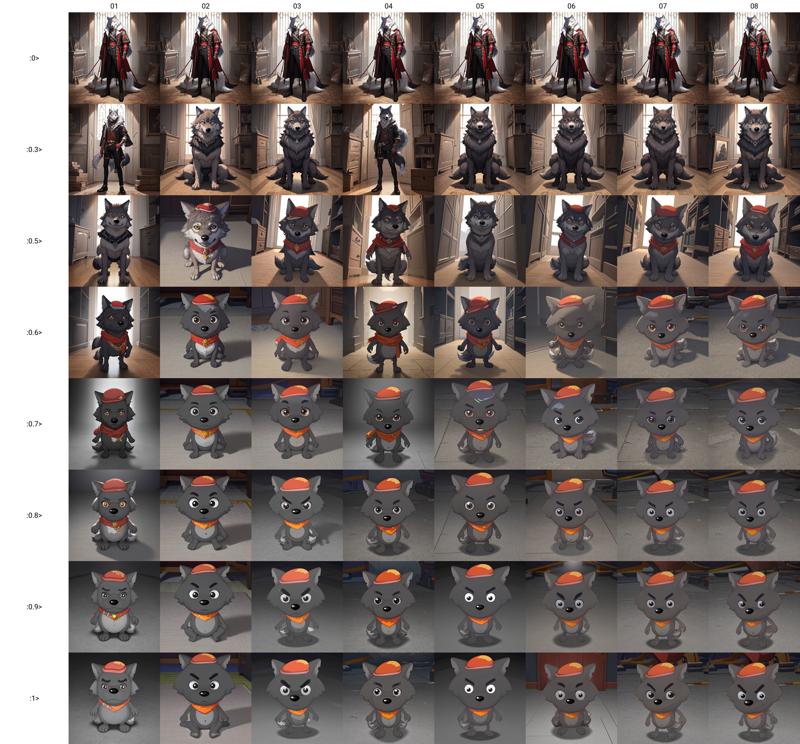
灰太狼 batch size=1 Wolffy, batch size=1
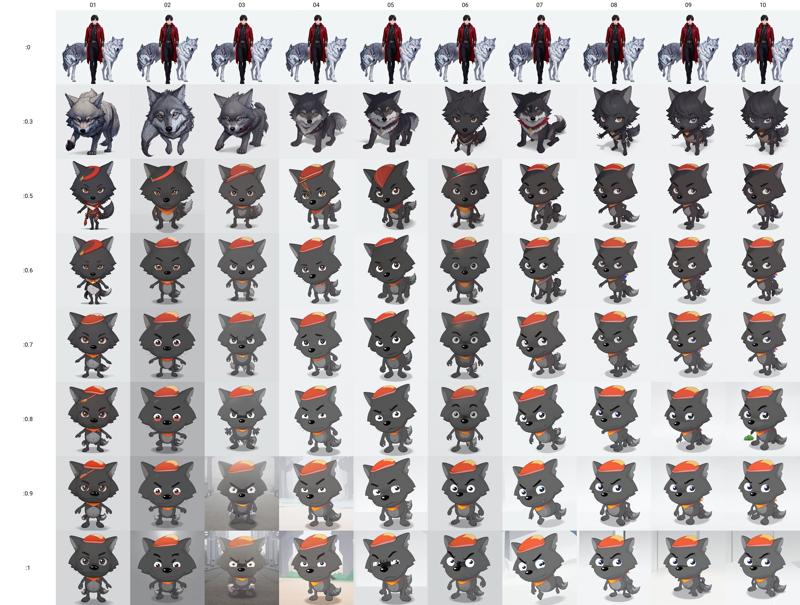
灰太狼 batch size=2 Wolffy, batch size=2
喜羊羊和灰太狼的模型拟合效果不佳应该是训练集的问题。要想训练喜羊羊这种非人类Q版动漫角色,难度肯定是比训练人类角色更大的,所以它对训练集的要求会比较高。在动漫中,经常会出现这些角色打斗的画面,那些动画师们(比如这次即将在7月19日上映的《喜羊羊与灰太狼》大电影9《守护》的总导演黄俊铭和陈力进,这里我夹带私货做个广告,这次似乎是机战主题,推荐大学生去看看)在画打戏时会画出很多姿势奇怪、身体变形、透视夸张的镜头,以加强画面张力。而我在做训练集时没有刻意回避这些镜头,因而影响了模型训练。在训练集的影响之下,batch size的影响微乎其微。
The poor fitting of the models for Weslie and Wolffy is likely due to issues with the training dataset. Training non-human chibi-style anime characters like Weslie is certainly more challenging than training human characters, so it requires a higher quality training dataset. In the anime, scenes of these characters fighting often appear, and the animators draw many shots with strange poses, body deformations, and exaggerated perspectives to enhance the tension of the scenes. When creating the training dataset, I didn't deliberately avoid these shots, which affected the model training. Under the influence of the training dataset, the impact of batch size is minimal.
到目前为止,我这里质量最好的是美羊羊的训练集(可能是因为美爷的打戏不多?),所以,接下来以美羊羊的Lora模型为例,探究一下batch size增大时,模型的还原度和泛化性到底是不是更好了。这里的还原度是指把角色画准确的能力,这里的泛化性是指画出训练集中没有的场景的能力。我对模型的评价方式为,用我的肉眼主观观察出图效果,原因有二:这是最直接的评价方式;我不懂类似CCIP那样的评判方式,不知道哪些比较适合。
So far, the highest quality training dataset I have is for the character Tibbie (perhaps because there aren't many fight scenes for her?). Therefore, I will use Tibbie's LoRA model as an example to explore whether increasing the batch size truly improves the model's fidelity and diversity. Here, fidelity refers to the ability to accurately draw the character, and diversity refers to the ability to create scenes not present in the training dataset. My evaluation method for the model is to subjectively observe the output results with my own eyes, for two reasons: it is the most direct evaluation method, and I don't understand evaluation methods like CCIP and am unsure which ones are more suitable.
出图参数如下:
The parameters for generating images are as follows:
Prompt: masterpiece, best quality, high detail, highres, 1girl, Tibbie, sheep, full body, looking at viewer, <lora:Tibbie1-000001:0>
Negative prompt: lowres, bad anatomy, bad hands, text, error, missing fingers, extra digit, fewer digits, cropped, worst quality, low quality, normal quality, jpeg artifacts, signature, watermark, username, blurry, overlapping, disfigured, ugly
Steps: 20, Sampler: DPM++ 2M, Schedule type: Karras, CFG scale: 7, Seed: 29464874, Size: 512x512, Model hash: 7c348e096a, Model: cuteyukimixAdorable_neochapter3, VAE hash: 235745af8d, VAE: animevae.pt, Clip skip: 2, Lora hashes: "Tibbie1-000001: 23ee3414dfc1", Script: X/Y/Z plot, X Type: Prompt S/R, X Values: "01,02,03,04,05,06,07,08", Y Type: Prompt S/R, Y Values: ":0,:0.3,:0.5,:0.6,:0.7,:0.8,:0.9,:1", Version: v1.9.3
出图结果如下:
The image results are as follows:

batch size=1
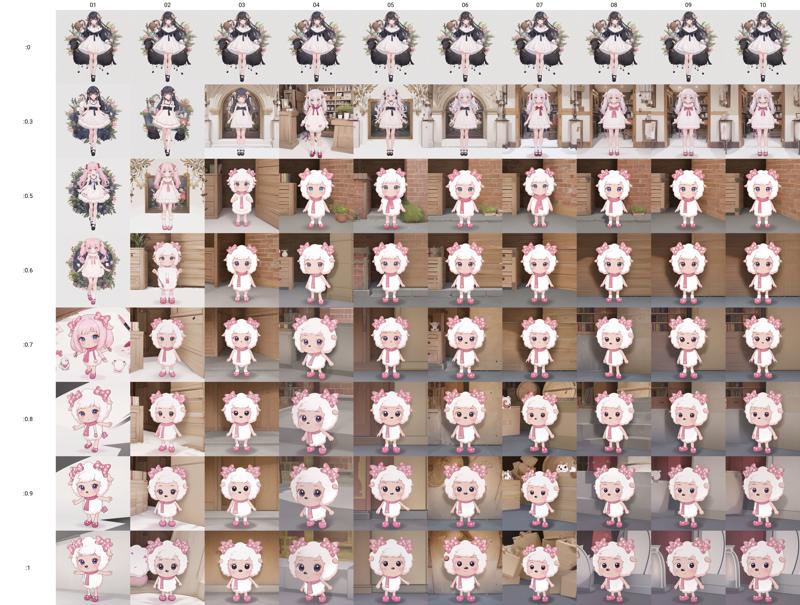
batch size=2
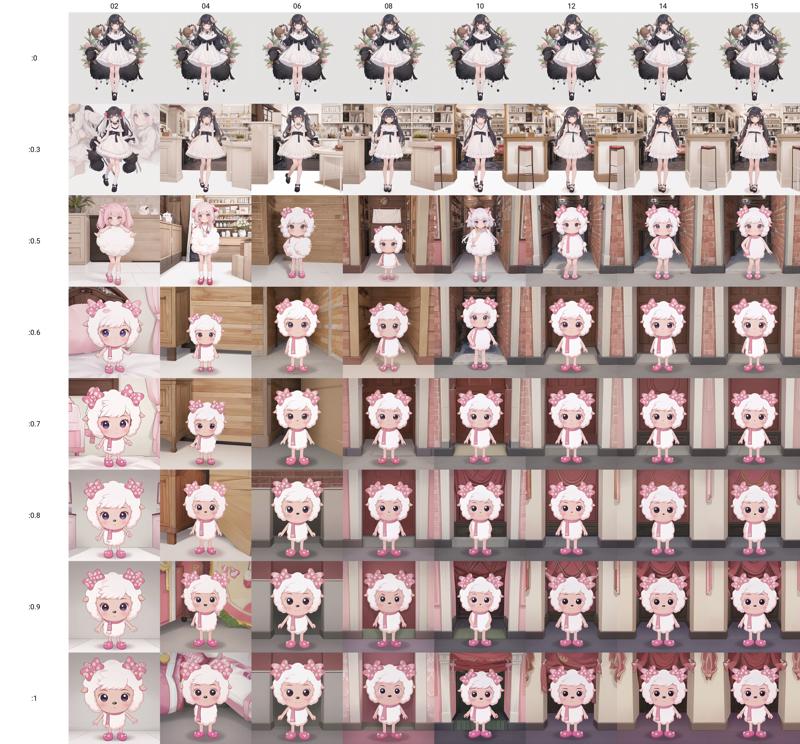
batch size=3
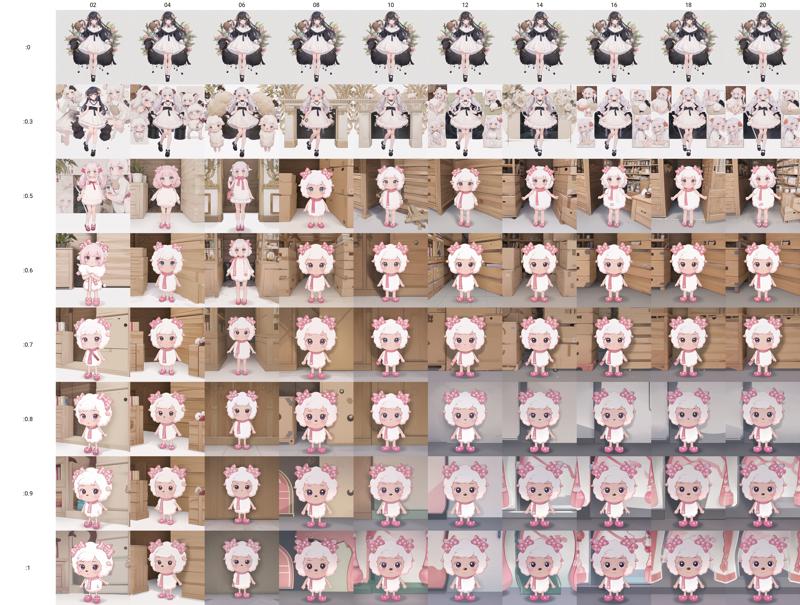
batch size=4
batch size从1提升到2之后,模型会更容易在较低权重下画出美羊羊的特征,且在较高权重下能比原来画得更像。也就是说,还原度确实有所提升。但是,batch size提升至3以上之后,就没有明显的优势了,甚至还原度反而不如batch size=2的时候。
After increasing the batch size from 1 to 2, the model is more capable of depicting Tibbie's features at a lower weight, and it can draw more accurately at a higher weight compared to before. In other words, the fidelity indeed improved. However, increasing the batch size to 3 or more does not show any significant advantage, and the fidelity is even lower than when the batch size is 2.
接下来画一些训练集中没有的场景,“坐在树上”:
Next, let's draw some scenes not present in the training dataset, such as 'sitting on tree':
Prompt: masterpiece, best quality, high detail, highres, 1girl, Tibbie, sheep, <lora:Tibbie1-000001:0>, sitting on tree, looking at viewer
Negative prompt: lowres, bad anatomy, bad hands, text, error, missing fingers, extra digit, fewer digits, cropped, worst quality, low quality, normal quality, jpeg artifacts, signature, watermark, username, blurry, overlapping, disfigured, ugly
Steps: 20, Sampler: DPM++ 2M, Schedule type: Karras, CFG scale: 7, Seed: 487059718, Size: 512x512, Model hash: 7c348e096a, Model: cuteyukimixAdorable_neochapter3, VAE hash: 235745af8d, VAE: animevae.pt, Clip skip: 2, Lora hashes: "Tibbie1-000001: 23ee3414dfc1", Script: X/Y/Z plot, X Type: Prompt S/R, X Values: "01,02,03,04,05,06,07,08", Y Type: Prompt S/R, Y Values: ":0,:0.3,:0.5,:0.6,:0.7,:0.8,:0.9,:1", Version: v1.9.3
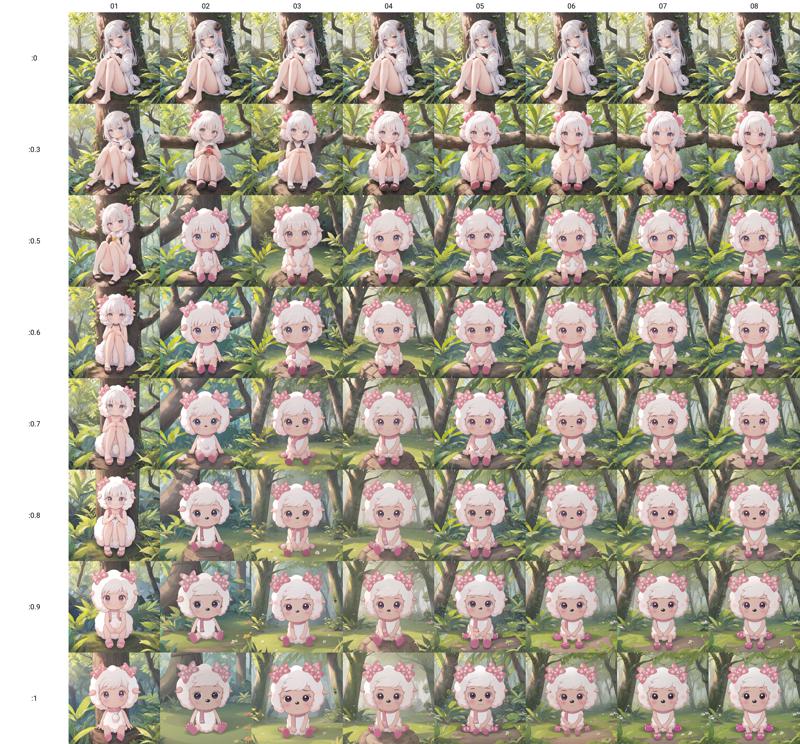
batch size=1
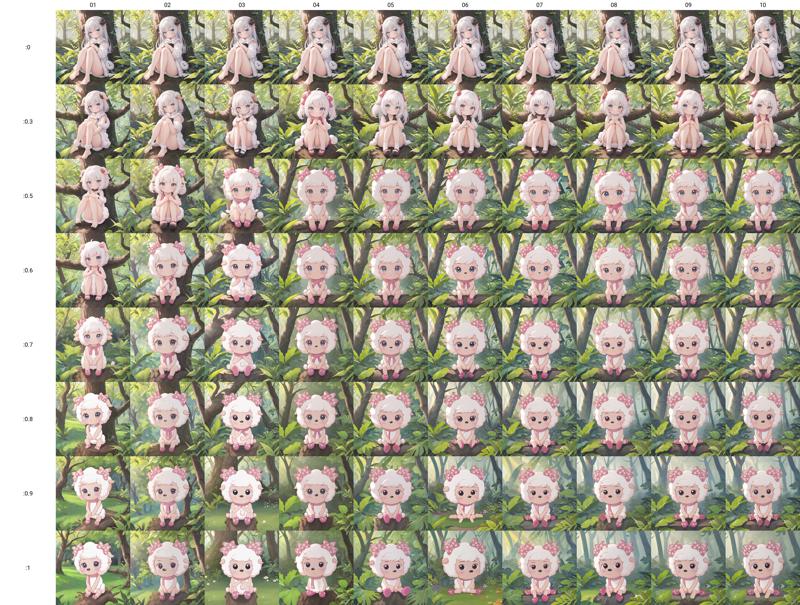
batch size=2
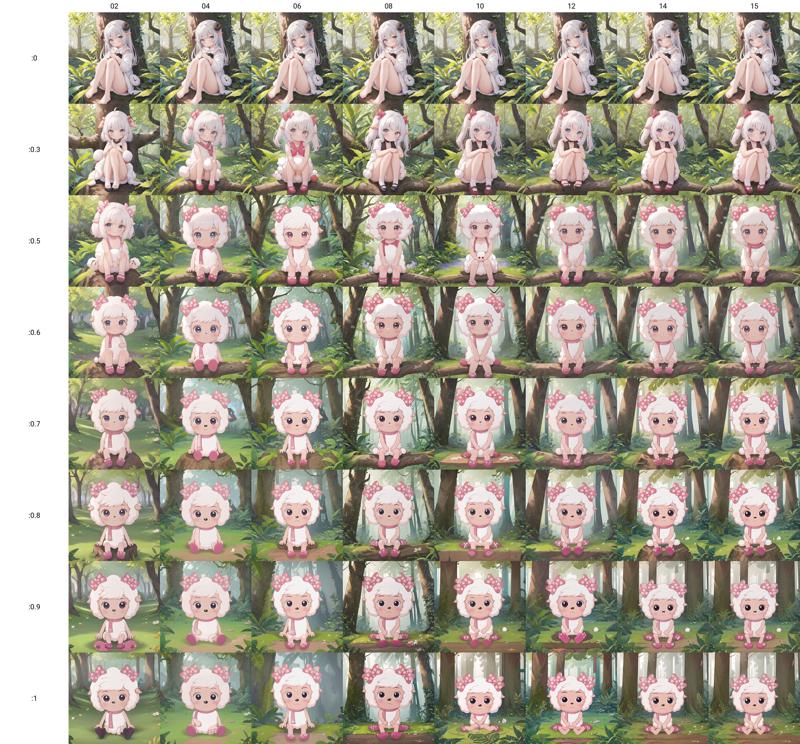
batch size=3
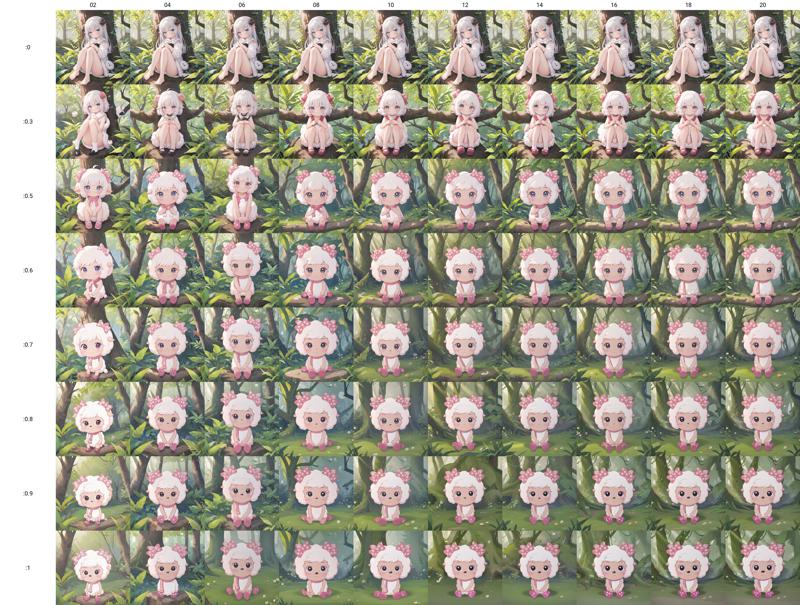
batch size=4
我们来看看树干是什么时候消失的。batch size=1时,模型权重达到0.8时,树干就开始变成石头或土地了。batch size=2时,模型权重达到0.8时依然能完好地画出树干的形态,第8个epoch的模型在权重为0.9时依然能表现出树桩的木纹肌理。batch size=3时,只有第8、14、15个epoch的模型把树干保留到了0.8的权重。batch size=4时,权重才0.7,树干就已经消失或覆上一层草地一样的青苔了。batch size为2时为泛化性最优情况,batch size更大时反而不如为1的时候。
Let's see when the tree trunk disappears. With a batch size of 1, the tree trunk starts turning into stone or ground when the model weight reaches 0.8. With a batch size of 2, the tree trunk's shape remains intact even at a model weight of 0.8, and the model from the 8th epoch still shows the wood grain texture of the stump at a weight of 0.9. With a batch size of 3, only the models from the 8th, 14th, and 15th epochs keep the tree trunk intact up to a weight of 0.8. With a batch size of 4, the tree trunk disappears or gets covered with grass-like moss at a weight of just 0.7. The optimal diversity occurs with a batch size of 2, and a larger batch size performs worse than a batch size of 1.
也许,“坐在树上”对于模型来说太简单了,让我们试试“躺在沙滩上”:
Maybe 'sitting in a tree' is too simple for the model. Let's try 'lying on beach':
Prompt: masterpiece, best quality, high detail, highres, 1girl lying on beach, Tibbie, sheep, full body, <lora:Tibbie1-000001:0>
Negative prompt: lowres, bad anatomy, bad hands, text, error, missing fingers, extra digit, fewer digits, cropped, worst quality, low quality, normal quality, jpeg artifacts, signature, watermark, username, blurry, overlapping, disfigured, ugly
Steps: 20, Sampler: DPM++ 2M, Schedule type: Karras, CFG scale: 7, Seed: 1680887032, Size: 512x512, Model hash: 7c348e096a, Model: cuteyukimixAdorable_neochapter3, VAE hash: 235745af8d, VAE: animevae.pt, Clip skip: 2, Lora hashes: "Tibbie1-000001: 23ee3414dfc1", Script: X/Y/Z plot, X Type: Prompt S/R, X Values: "01,02,03,04,05,06,07,08", Y Type: Prompt S/R, Y Values: ":0,:0.3,:0.5,:0.6,:0.7,:0.8,:0.9,:1", Version: v1.9.3
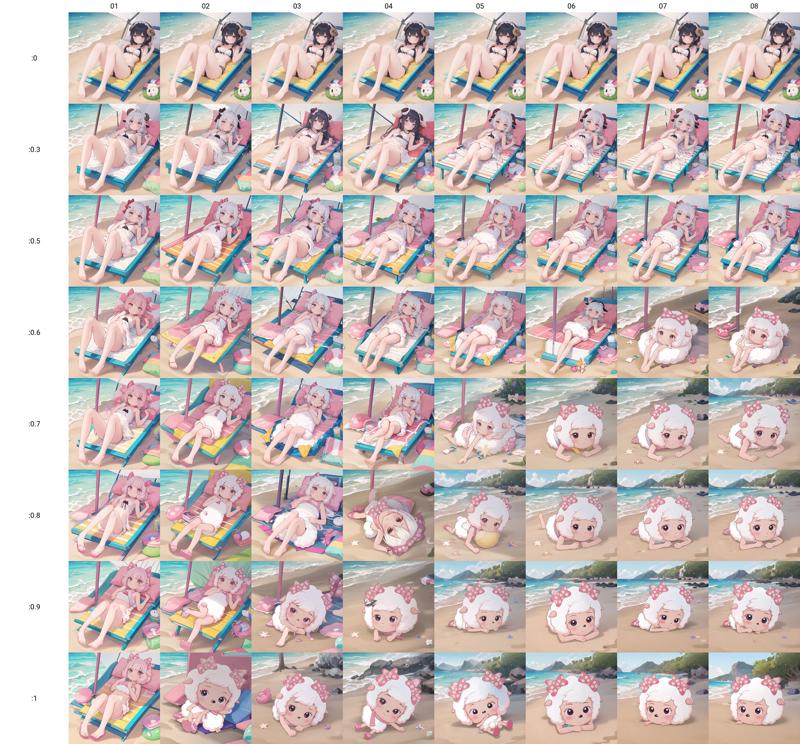
batch size=1
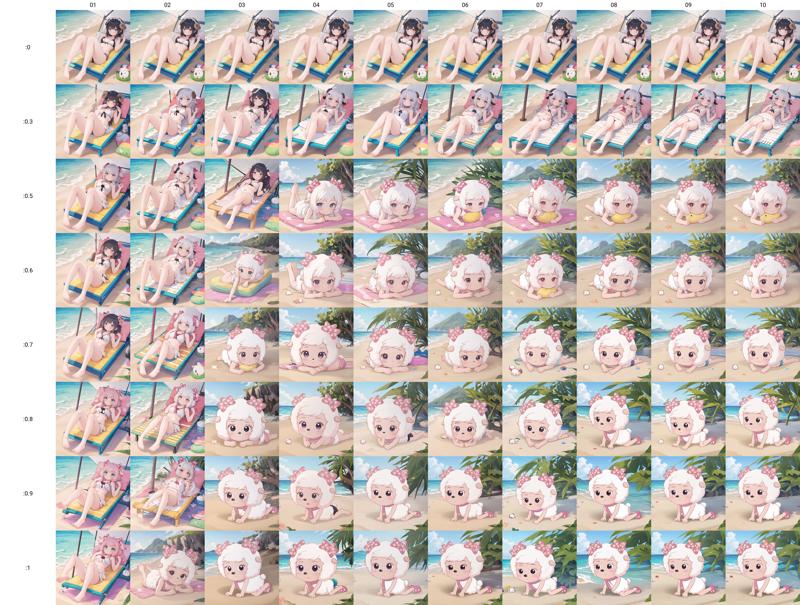
batch size=2
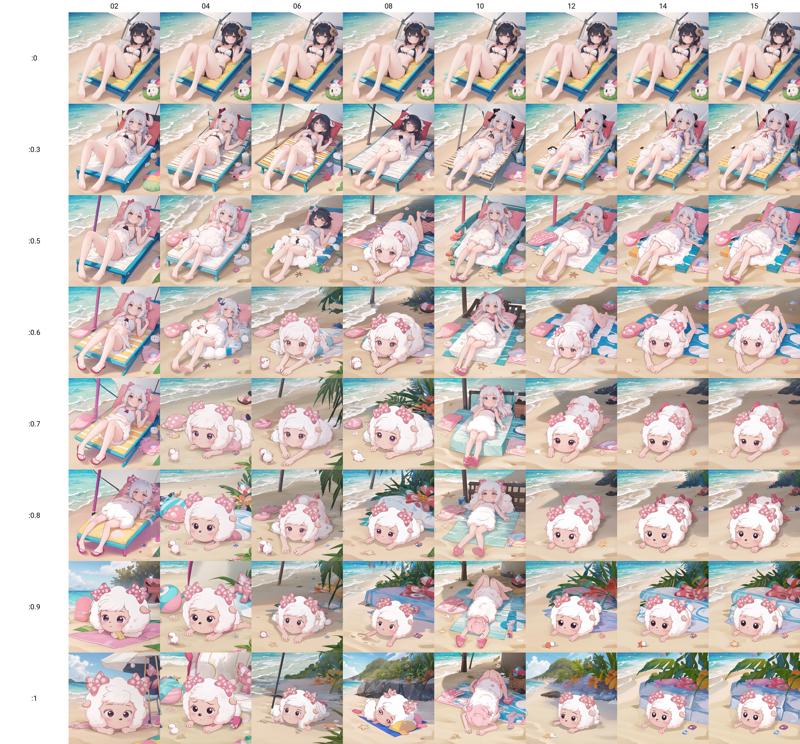
batch size=3
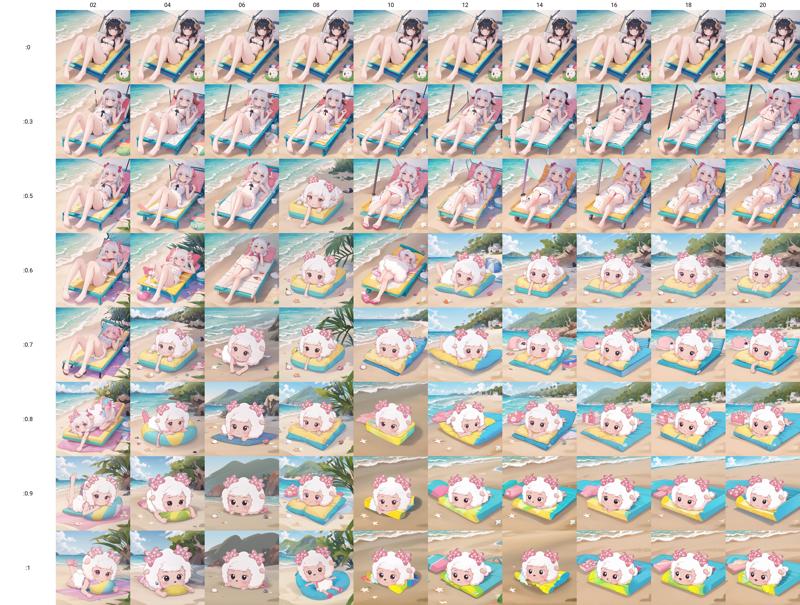
batch size=4
在这里,沙滩床是我在提示词中没有提到,大模型自己发挥的内容,所以沙滩床的消失不能用于评判模型泛化性。我们主要还是看看躺着(趴着也是lie)的姿势的崩坏程度。batch size=1时,较准确的美羊羊形象到0.7的权重时才出现,权重增加到1之后,美羊羊直接就只剩一个头了。batch size=2时,权重0.5时就能画出较准确的美羊羊趴在沙滩上的形象,尽管权重超过0.8后美羊羊坐起来了,没有严格地遵循提示词。batch size=3时,到了0.7的权重才出现美羊羊的形象,并且成功地将提示词中的动作描述保持到了最后,但是崩坏一直很严重。batch size=4时,沙滩床倒是神奇般地保留到了最后,美羊羊的形象也在0.6的权重时出现了,而且也一直保持着提示词中的动作描述,但是依然有较严重的崩坏。故而,batch size的最优值依然是2。看上去,batch size提得太高了之后,lora对提示词的理解会更好,但是主体物的训练效果也会打折扣。这可能是因为我训练的角色的特殊性,可能只能让模型慢慢学习才能获得良好的效果。
Here, the beach bed was not mentioned in my prompts and was generated by the checkpoint itself, so the disappearance of the beach bed cannot be used to judge the lora's diversity. We mainly need to look at the degradation of the 'lying down' (or 'lying prone') posture. With a batch size of 1, a fairly accurate image of Tibbie appears at a weight of 0.7, but after the weight increases to 1, only Tibbie's head remains. With a batch size of 2, an accurate image of Tibbie lying on the beach appears at a weight of 0.5, although after the weight exceeds 0.8, Tibbie starts sitting up, not strictly following the prompt. With a batch size of 3, an image of Tibbie appears at a weight of 0.7, successfully maintaining the action described in the prompt till the end, but with severe degradation throughout. With a batch size of 4, the beach bed surprisingly remains till the end, and an image of Tibbie appears at a weight of 0.6, maintaining the action described in the prompt, but still with significant degradation. Therefore, the optimal batch size remains 2. It seems that when the batch size is too high, the LoRA model understands the prompt better, but the training effect on the main subject is compromised. This might be due to the special nature of the characters I am training, which may require the model to learn slowlier to achieve good results.
总结一下,对于角色lora的训练来说,最重要的依然是训练集(包括图片和标签)。在较优质的训练集下,适量增大batch size有助于提升模型的质量,故训练时增大batch size是值得尝试的。但是,batch size不宜过大。有些角色,由于其复杂性,可能不适合过快的拟合速度,用较低的batch size缓慢拟合会更好。
To summarize, for training character LoRA models, the most important factor is still the training dataset (including images and tags). With a high-quality training dataset, moderately increasing the batch size can help improve the model's quality, so it is worth trying to increase the batch size during training. However, the batch size should not be too large. Some characters, due to their complexity, may not be suitable for rapid fitting, and therefore using a lower batch size for slower fitting may be more effective.





![[Alchemy Notes] Does increasing batch size really help in training a LoRA?](https://image.civitai.com/xG1nkqKTMzGDvpLrqFT7WA/f7dc2239-7710-4ce6-9fae-485799981eca/width=1320/屏幕截图 2024-06-25 015627.jpeg)